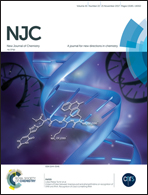Competition between the donor and acceptor hydrogen bonds of the threads in the formation of [2]rotaxanes by clipping reaction†
Abstract
The synthesis of benzylic amide [2]rotaxanes using 1,2-bis(aminocarbonyl-(1′-tert-butyl-1H-pyrazole-[3′]5′-yl))-ethanes as templates is reported. These templates are equipped with tert-butyl pyrazole-based stoppers and have donor (N–H) and acceptor (C![[double bond, length as m-dash]](https://www.rsc.org/images/entities/char_e001.gif) O) hydrogen bond groups. The synthesis of [2]rotaxanes has been shown to be highly dependent on the tert-butylpyrazole stoppers. While the thread with 1′,3′-disubstituted pyrazoles as stopper units was shown to be an excellent template for the synthesis of [2]rotaxanes, the thread with 1′,5′-disubstituted pyrazoles as stopper units did not yield the expected [2]rotaxane. The structure of the synthesized [2]rotaxanes was characterized using NMR experiments and X-ray diffraction, with the latter showing that the macrocycle adopts a distorted chair conformation. An in-depth study of the isolated thread's X-ray structures and concentration-dependent NMR experiments seem to explain the dependence of the rotaxane formation on the substitution pattern of the thread's pyrazole stoppers.
O) hydrogen bond groups. The synthesis of [2]rotaxanes has been shown to be highly dependent on the tert-butylpyrazole stoppers. While the thread with 1′,3′-disubstituted pyrazoles as stopper units was shown to be an excellent template for the synthesis of [2]rotaxanes, the thread with 1′,5′-disubstituted pyrazoles as stopper units did not yield the expected [2]rotaxane. The structure of the synthesized [2]rotaxanes was characterized using NMR experiments and X-ray diffraction, with the latter showing that the macrocycle adopts a distorted chair conformation. An in-depth study of the isolated thread's X-ray structures and concentration-dependent NMR experiments seem to explain the dependence of the rotaxane formation on the substitution pattern of the thread's pyrazole stoppers.
![Graphical abstract: Competition between the donor and acceptor hydrogen bonds of the threads in the formation of [2]rotaxanes by clipping reaction](/en/Image/Get?imageInfo.ImageType=GA&imageInfo.ImageIdentifier.ManuscriptID=C7NJ02443F&imageInfo.ImageIdentifier.Year=2017)


 Please wait while we load your content...
Please wait while we load your content...